Business Environment Report: Macro Factors and Organizational Impact
VerifiedAdded on 2020/06/05
|13
|3948
|34
Report
AI Summary
This report delves into the intricacies of the business environment, examining the characteristics and functions of private, public, and voluntary organizations. It explores the impact of macro-environmental factors, such as political, economic, social, technological, legal, and environmental influences, on business operations, using Mark & Spencer (M&S) as a case study. The report analyzes the size, scope, and legal structures of different organizational types, highlighting how their objectives are linked to various organizational functions like marketing, production, and research. Furthermore, it identifies both positive and negative impacts of the macro environment on M&S, assessing the company's strengths and weaknesses in relation to external factors. The analysis encompasses the significance of innovation, monitoring processes, and how these elements contribute to achieving organizational goals. The report provides a detailed understanding of how businesses navigate and respond to the external forces shaping their success, emphasizing the critical role of strategic adaptation and analysis within the dynamic business landscape.
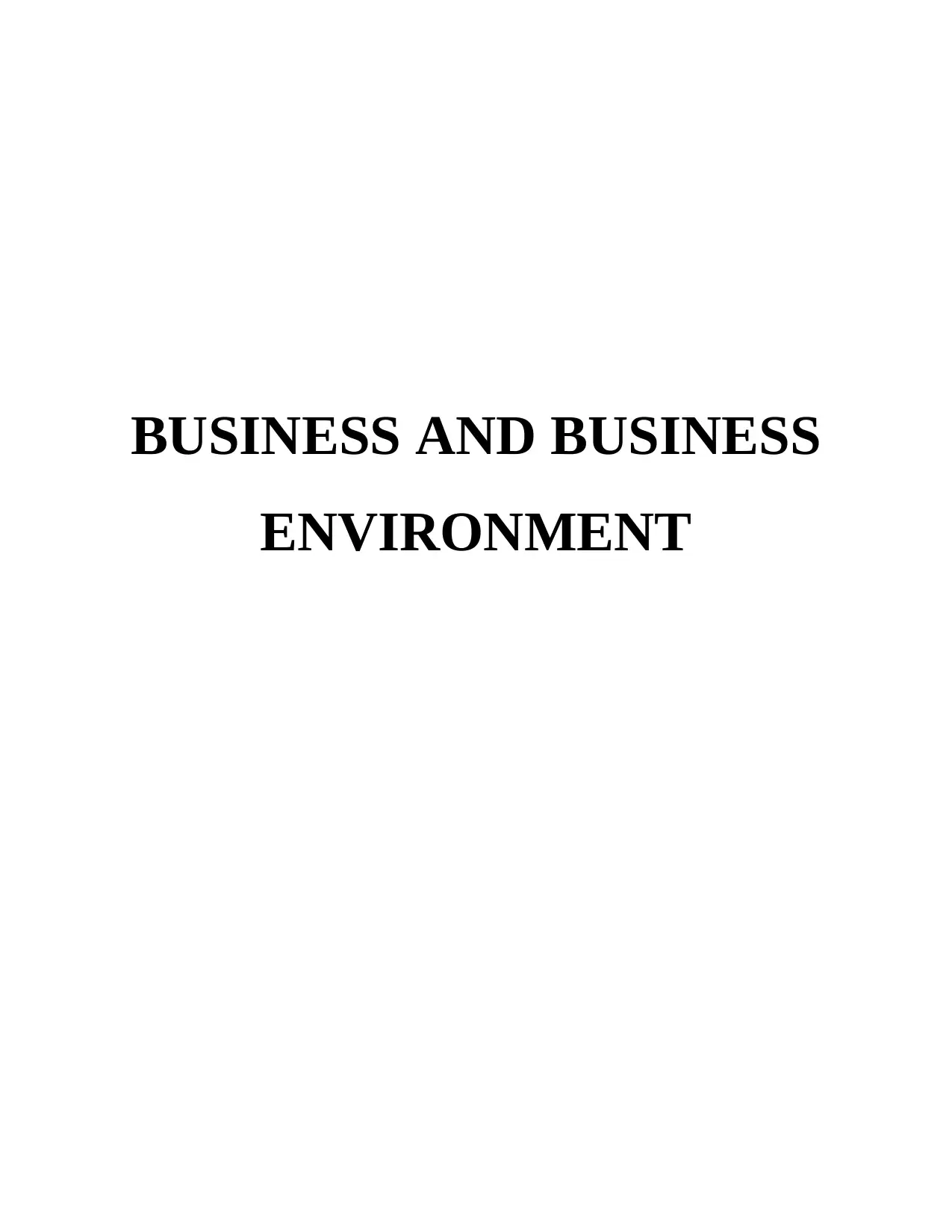
BUSINESS AND BUSINESS
ENVIRONMENT
ENVIRONMENT
Paraphrase This Document
Need a fresh take? Get an instant paraphrase of this document with our AI Paraphraser
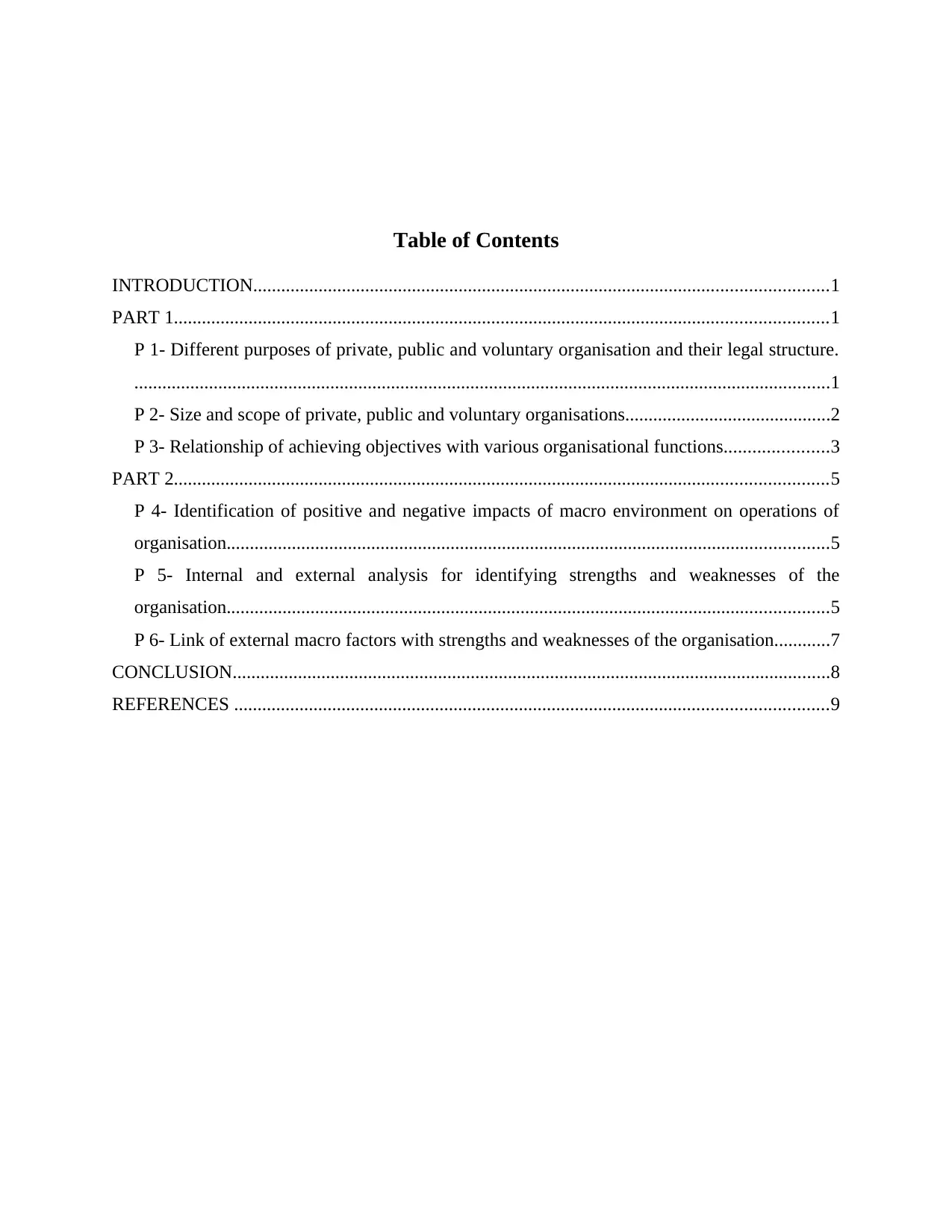
Table of Contents
INTRODUCTION...........................................................................................................................1
PART 1............................................................................................................................................1
P 1- Different purposes of private, public and voluntary organisation and their legal structure.
.....................................................................................................................................................1
P 2- Size and scope of private, public and voluntary organisations............................................2
P 3- Relationship of achieving objectives with various organisational functions......................3
PART 2............................................................................................................................................5
P 4- Identification of positive and negative impacts of macro environment on operations of
organisation.................................................................................................................................5
P 5- Internal and external analysis for identifying strengths and weaknesses of the
organisation.................................................................................................................................5
P 6- Link of external macro factors with strengths and weaknesses of the organisation............7
CONCLUSION................................................................................................................................8
REFERENCES ...............................................................................................................................9
INTRODUCTION...........................................................................................................................1
PART 1............................................................................................................................................1
P 1- Different purposes of private, public and voluntary organisation and their legal structure.
.....................................................................................................................................................1
P 2- Size and scope of private, public and voluntary organisations............................................2
P 3- Relationship of achieving objectives with various organisational functions......................3
PART 2............................................................................................................................................5
P 4- Identification of positive and negative impacts of macro environment on operations of
organisation.................................................................................................................................5
P 5- Internal and external analysis for identifying strengths and weaknesses of the
organisation.................................................................................................................................5
P 6- Link of external macro factors with strengths and weaknesses of the organisation............7
CONCLUSION................................................................................................................................8
REFERENCES ...............................................................................................................................9
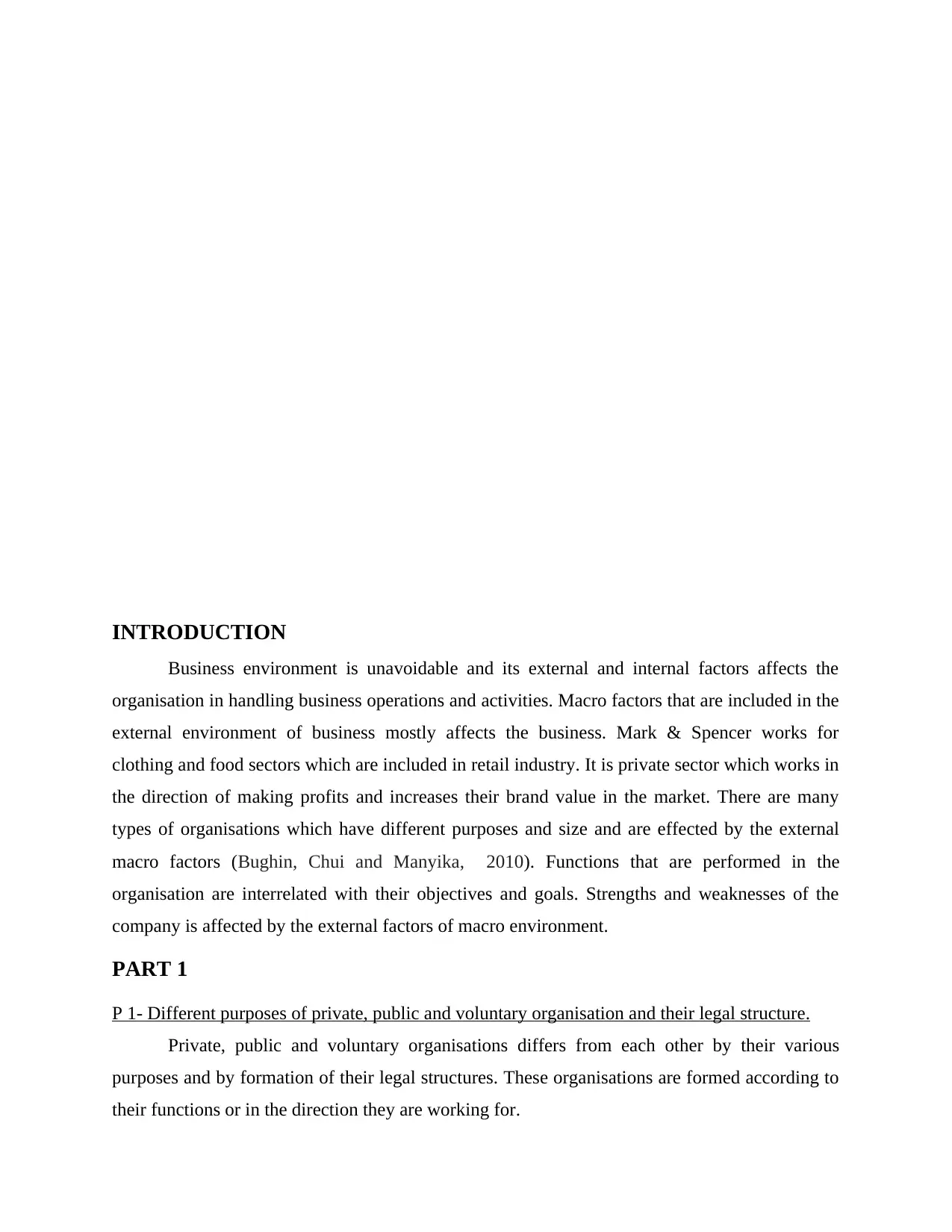
INTRODUCTION
Business environment is unavoidable and its external and internal factors affects the
organisation in handling business operations and activities. Macro factors that are included in the
external environment of business mostly affects the business. Mark & Spencer works for
clothing and food sectors which are included in retail industry. It is private sector which works in
the direction of making profits and increases their brand value in the market. There are many
types of organisations which have different purposes and size and are effected by the external
macro factors (Bughin, Chui and Manyika, 2010). Functions that are performed in the
organisation are interrelated with their objectives and goals. Strengths and weaknesses of the
company is affected by the external factors of macro environment.
PART 1
P 1- Different purposes of private, public and voluntary organisation and their legal structure.
Private, public and voluntary organisations differs from each other by their various
purposes and by formation of their legal structures. These organisations are formed according to
their functions or in the direction they are working for.
Business environment is unavoidable and its external and internal factors affects the
organisation in handling business operations and activities. Macro factors that are included in the
external environment of business mostly affects the business. Mark & Spencer works for
clothing and food sectors which are included in retail industry. It is private sector which works in
the direction of making profits and increases their brand value in the market. There are many
types of organisations which have different purposes and size and are effected by the external
macro factors (Bughin, Chui and Manyika, 2010). Functions that are performed in the
organisation are interrelated with their objectives and goals. Strengths and weaknesses of the
company is affected by the external factors of macro environment.
PART 1
P 1- Different purposes of private, public and voluntary organisation and their legal structure.
Private, public and voluntary organisations differs from each other by their various
purposes and by formation of their legal structures. These organisations are formed according to
their functions or in the direction they are working for.
⊘ This is a preview!⊘
Do you want full access?
Subscribe today to unlock all pages.

Trusted by 1+ million students worldwide
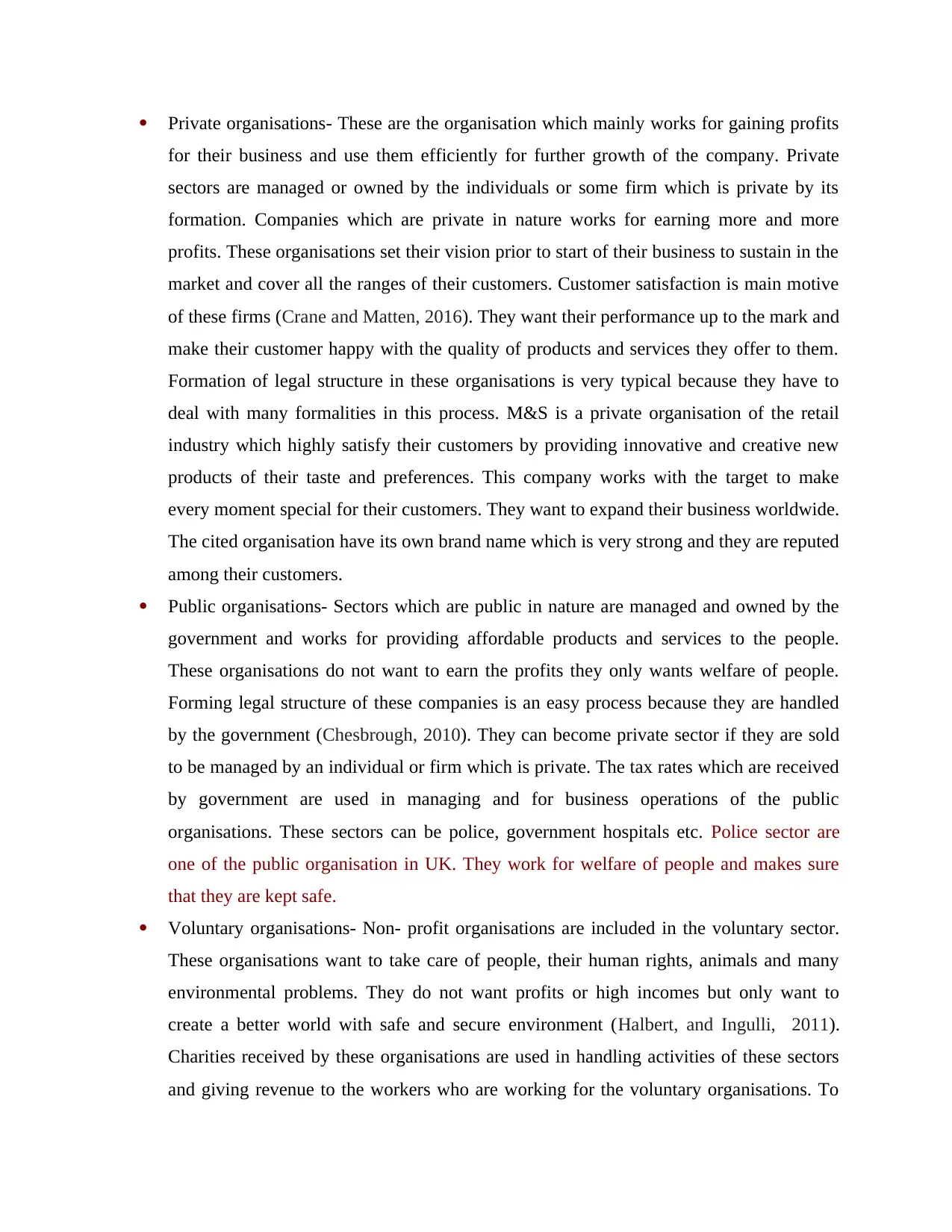
Private organisations- These are the organisation which mainly works for gaining profits
for their business and use them efficiently for further growth of the company. Private
sectors are managed or owned by the individuals or some firm which is private by its
formation. Companies which are private in nature works for earning more and more
profits. These organisations set their vision prior to start of their business to sustain in the
market and cover all the ranges of their customers. Customer satisfaction is main motive
of these firms (Crane and Matten, 2016). They want their performance up to the mark and
make their customer happy with the quality of products and services they offer to them.
Formation of legal structure in these organisations is very typical because they have to
deal with many formalities in this process. M&S is a private organisation of the retail
industry which highly satisfy their customers by providing innovative and creative new
products of their taste and preferences. This company works with the target to make
every moment special for their customers. They want to expand their business worldwide.
The cited organisation have its own brand name which is very strong and they are reputed
among their customers.
Public organisations- Sectors which are public in nature are managed and owned by the
government and works for providing affordable products and services to the people.
These organisations do not want to earn the profits they only wants welfare of people.
Forming legal structure of these companies is an easy process because they are handled
by the government (Chesbrough, 2010). They can become private sector if they are sold
to be managed by an individual or firm which is private. The tax rates which are received
by government are used in managing and for business operations of the public
organisations. These sectors can be police, government hospitals etc. Police sector are
one of the public organisation in UK. They work for welfare of people and makes sure
that they are kept safe.
Voluntary organisations- Non- profit organisations are included in the voluntary sector.
These organisations want to take care of people, their human rights, animals and many
environmental problems. They do not want profits or high incomes but only want to
create a better world with safe and secure environment (Halbert, and Ingulli, 2011).
Charities received by these organisations are used in handling activities of these sectors
and giving revenue to the workers who are working for the voluntary organisations. To
for their business and use them efficiently for further growth of the company. Private
sectors are managed or owned by the individuals or some firm which is private by its
formation. Companies which are private in nature works for earning more and more
profits. These organisations set their vision prior to start of their business to sustain in the
market and cover all the ranges of their customers. Customer satisfaction is main motive
of these firms (Crane and Matten, 2016). They want their performance up to the mark and
make their customer happy with the quality of products and services they offer to them.
Formation of legal structure in these organisations is very typical because they have to
deal with many formalities in this process. M&S is a private organisation of the retail
industry which highly satisfy their customers by providing innovative and creative new
products of their taste and preferences. This company works with the target to make
every moment special for their customers. They want to expand their business worldwide.
The cited organisation have its own brand name which is very strong and they are reputed
among their customers.
Public organisations- Sectors which are public in nature are managed and owned by the
government and works for providing affordable products and services to the people.
These organisations do not want to earn the profits they only wants welfare of people.
Forming legal structure of these companies is an easy process because they are handled
by the government (Chesbrough, 2010). They can become private sector if they are sold
to be managed by an individual or firm which is private. The tax rates which are received
by government are used in managing and for business operations of the public
organisations. These sectors can be police, government hospitals etc. Police sector are
one of the public organisation in UK. They work for welfare of people and makes sure
that they are kept safe.
Voluntary organisations- Non- profit organisations are included in the voluntary sector.
These organisations want to take care of people, their human rights, animals and many
environmental problems. They do not want profits or high incomes but only want to
create a better world with safe and secure environment (Halbert, and Ingulli, 2011).
Charities received by these organisations are used in handling activities of these sectors
and giving revenue to the workers who are working for the voluntary organisations. To
Paraphrase This Document
Need a fresh take? Get an instant paraphrase of this document with our AI Paraphraser
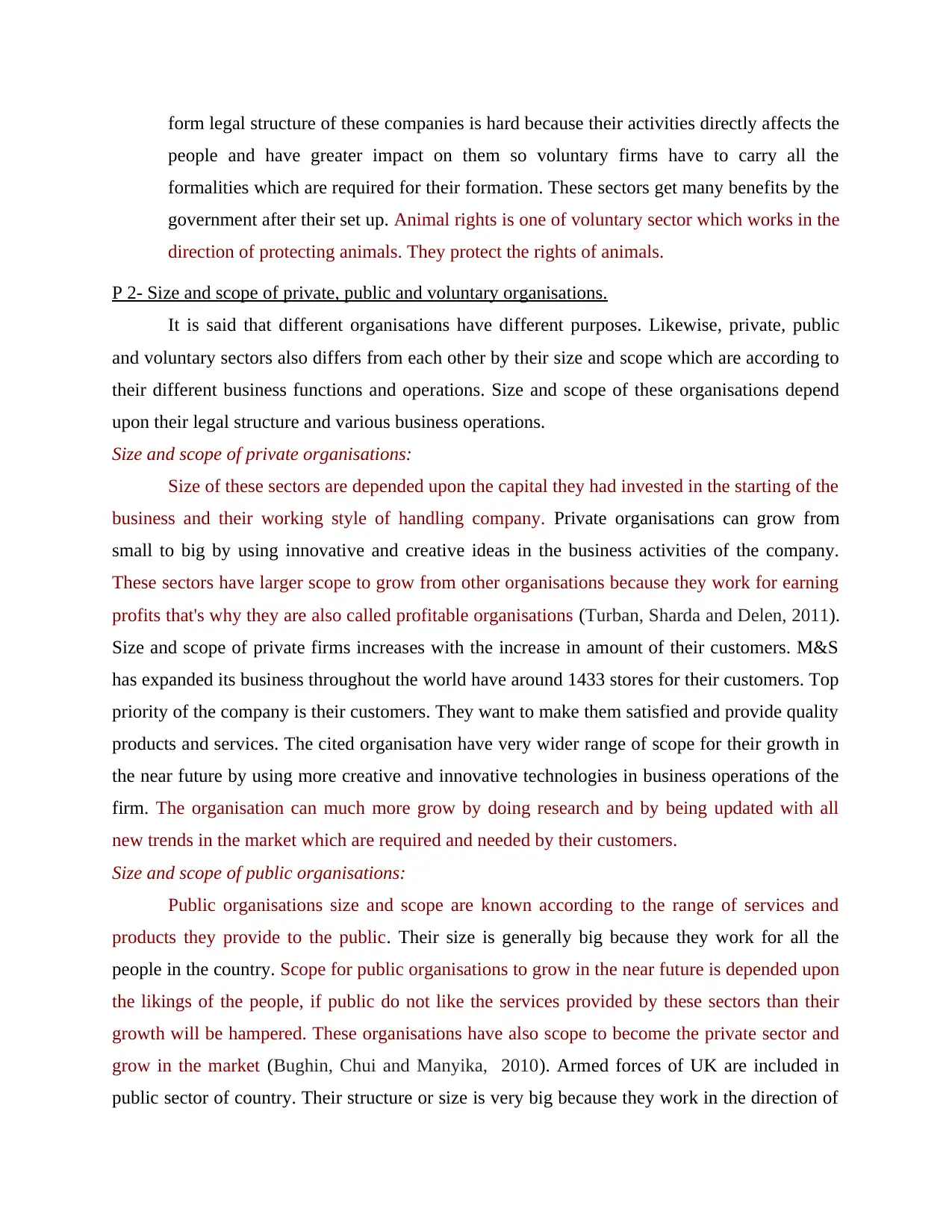
form legal structure of these companies is hard because their activities directly affects the
people and have greater impact on them so voluntary firms have to carry all the
formalities which are required for their formation. These sectors get many benefits by the
government after their set up. Animal rights is one of voluntary sector which works in the
direction of protecting animals. They protect the rights of animals.
P 2- Size and scope of private, public and voluntary organisations.
It is said that different organisations have different purposes. Likewise, private, public
and voluntary sectors also differs from each other by their size and scope which are according to
their different business functions and operations. Size and scope of these organisations depend
upon their legal structure and various business operations.
Size and scope of private organisations:
Size of these sectors are depended upon the capital they had invested in the starting of the
business and their working style of handling company. Private organisations can grow from
small to big by using innovative and creative ideas in the business activities of the company.
These sectors have larger scope to grow from other organisations because they work for earning
profits that's why they are also called profitable organisations (Turban, Sharda and Delen, 2011).
Size and scope of private firms increases with the increase in amount of their customers. M&S
has expanded its business throughout the world have around 1433 stores for their customers. Top
priority of the company is their customers. They want to make them satisfied and provide quality
products and services. The cited organisation have very wider range of scope for their growth in
the near future by using more creative and innovative technologies in business operations of the
firm. The organisation can much more grow by doing research and by being updated with all
new trends in the market which are required and needed by their customers.
Size and scope of public organisations:
Public organisations size and scope are known according to the range of services and
products they provide to the public. Their size is generally big because they work for all the
people in the country. Scope for public organisations to grow in the near future is depended upon
the likings of the people, if public do not like the services provided by these sectors than their
growth will be hampered. These organisations have also scope to become the private sector and
grow in the market (Bughin, Chui and Manyika, 2010). Armed forces of UK are included in
public sector of country. Their structure or size is very big because they work in the direction of
people and have greater impact on them so voluntary firms have to carry all the
formalities which are required for their formation. These sectors get many benefits by the
government after their set up. Animal rights is one of voluntary sector which works in the
direction of protecting animals. They protect the rights of animals.
P 2- Size and scope of private, public and voluntary organisations.
It is said that different organisations have different purposes. Likewise, private, public
and voluntary sectors also differs from each other by their size and scope which are according to
their different business functions and operations. Size and scope of these organisations depend
upon their legal structure and various business operations.
Size and scope of private organisations:
Size of these sectors are depended upon the capital they had invested in the starting of the
business and their working style of handling company. Private organisations can grow from
small to big by using innovative and creative ideas in the business activities of the company.
These sectors have larger scope to grow from other organisations because they work for earning
profits that's why they are also called profitable organisations (Turban, Sharda and Delen, 2011).
Size and scope of private firms increases with the increase in amount of their customers. M&S
has expanded its business throughout the world have around 1433 stores for their customers. Top
priority of the company is their customers. They want to make them satisfied and provide quality
products and services. The cited organisation have very wider range of scope for their growth in
the near future by using more creative and innovative technologies in business operations of the
firm. The organisation can much more grow by doing research and by being updated with all
new trends in the market which are required and needed by their customers.
Size and scope of public organisations:
Public organisations size and scope are known according to the range of services and
products they provide to the public. Their size is generally big because they work for all the
people in the country. Scope for public organisations to grow in the near future is depended upon
the likings of the people, if public do not like the services provided by these sectors than their
growth will be hampered. These organisations have also scope to become the private sector and
grow in the market (Bughin, Chui and Manyika, 2010). Armed forces of UK are included in
public sector of country. Their structure or size is very big because they work in the direction of
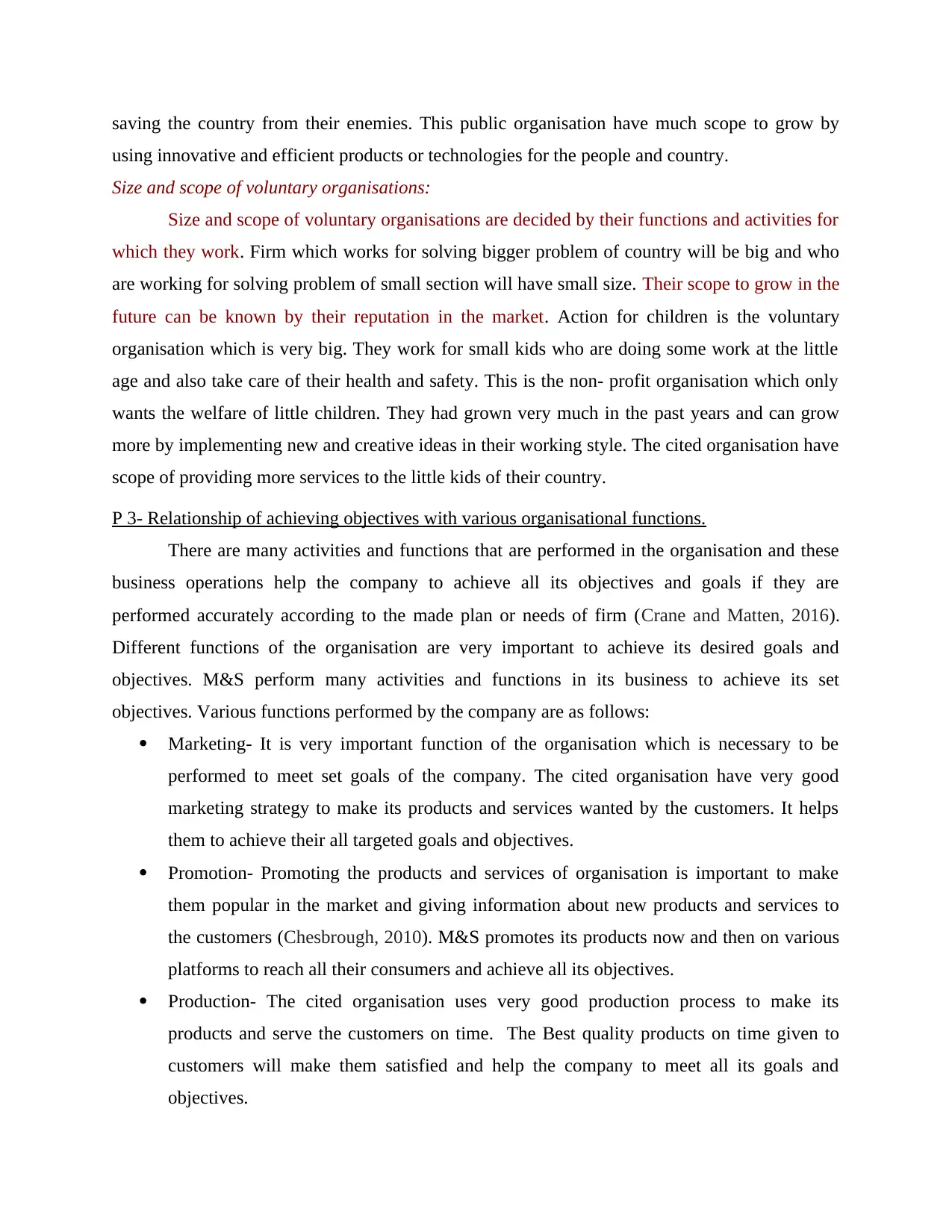
saving the country from their enemies. This public organisation have much scope to grow by
using innovative and efficient products or technologies for the people and country.
Size and scope of voluntary organisations:
Size and scope of voluntary organisations are decided by their functions and activities for
which they work. Firm which works for solving bigger problem of country will be big and who
are working for solving problem of small section will have small size. Their scope to grow in the
future can be known by their reputation in the market. Action for children is the voluntary
organisation which is very big. They work for small kids who are doing some work at the little
age and also take care of their health and safety. This is the non- profit organisation which only
wants the welfare of little children. They had grown very much in the past years and can grow
more by implementing new and creative ideas in their working style. The cited organisation have
scope of providing more services to the little kids of their country.
P 3- Relationship of achieving objectives with various organisational functions.
There are many activities and functions that are performed in the organisation and these
business operations help the company to achieve all its objectives and goals if they are
performed accurately according to the made plan or needs of firm (Crane and Matten, 2016).
Different functions of the organisation are very important to achieve its desired goals and
objectives. M&S perform many activities and functions in its business to achieve its set
objectives. Various functions performed by the company are as follows:
Marketing- It is very important function of the organisation which is necessary to be
performed to meet set goals of the company. The cited organisation have very good
marketing strategy to make its products and services wanted by the customers. It helps
them to achieve their all targeted goals and objectives.
Promotion- Promoting the products and services of organisation is important to make
them popular in the market and giving information about new products and services to
the customers (Chesbrough, 2010). M&S promotes its products now and then on various
platforms to reach all their consumers and achieve all its objectives.
Production- The cited organisation uses very good production process to make its
products and serve the customers on time. The Best quality products on time given to
customers will make them satisfied and help the company to meet all its goals and
objectives.
using innovative and efficient products or technologies for the people and country.
Size and scope of voluntary organisations:
Size and scope of voluntary organisations are decided by their functions and activities for
which they work. Firm which works for solving bigger problem of country will be big and who
are working for solving problem of small section will have small size. Their scope to grow in the
future can be known by their reputation in the market. Action for children is the voluntary
organisation which is very big. They work for small kids who are doing some work at the little
age and also take care of their health and safety. This is the non- profit organisation which only
wants the welfare of little children. They had grown very much in the past years and can grow
more by implementing new and creative ideas in their working style. The cited organisation have
scope of providing more services to the little kids of their country.
P 3- Relationship of achieving objectives with various organisational functions.
There are many activities and functions that are performed in the organisation and these
business operations help the company to achieve all its objectives and goals if they are
performed accurately according to the made plan or needs of firm (Crane and Matten, 2016).
Different functions of the organisation are very important to achieve its desired goals and
objectives. M&S perform many activities and functions in its business to achieve its set
objectives. Various functions performed by the company are as follows:
Marketing- It is very important function of the organisation which is necessary to be
performed to meet set goals of the company. The cited organisation have very good
marketing strategy to make its products and services wanted by the customers. It helps
them to achieve their all targeted goals and objectives.
Promotion- Promoting the products and services of organisation is important to make
them popular in the market and giving information about new products and services to
the customers (Chesbrough, 2010). M&S promotes its products now and then on various
platforms to reach all their consumers and achieve all its objectives.
Production- The cited organisation uses very good production process to make its
products and serve the customers on time. The Best quality products on time given to
customers will make them satisfied and help the company to meet all its goals and
objectives.
⊘ This is a preview!⊘
Do you want full access?
Subscribe today to unlock all pages.

Trusted by 1+ million students worldwide
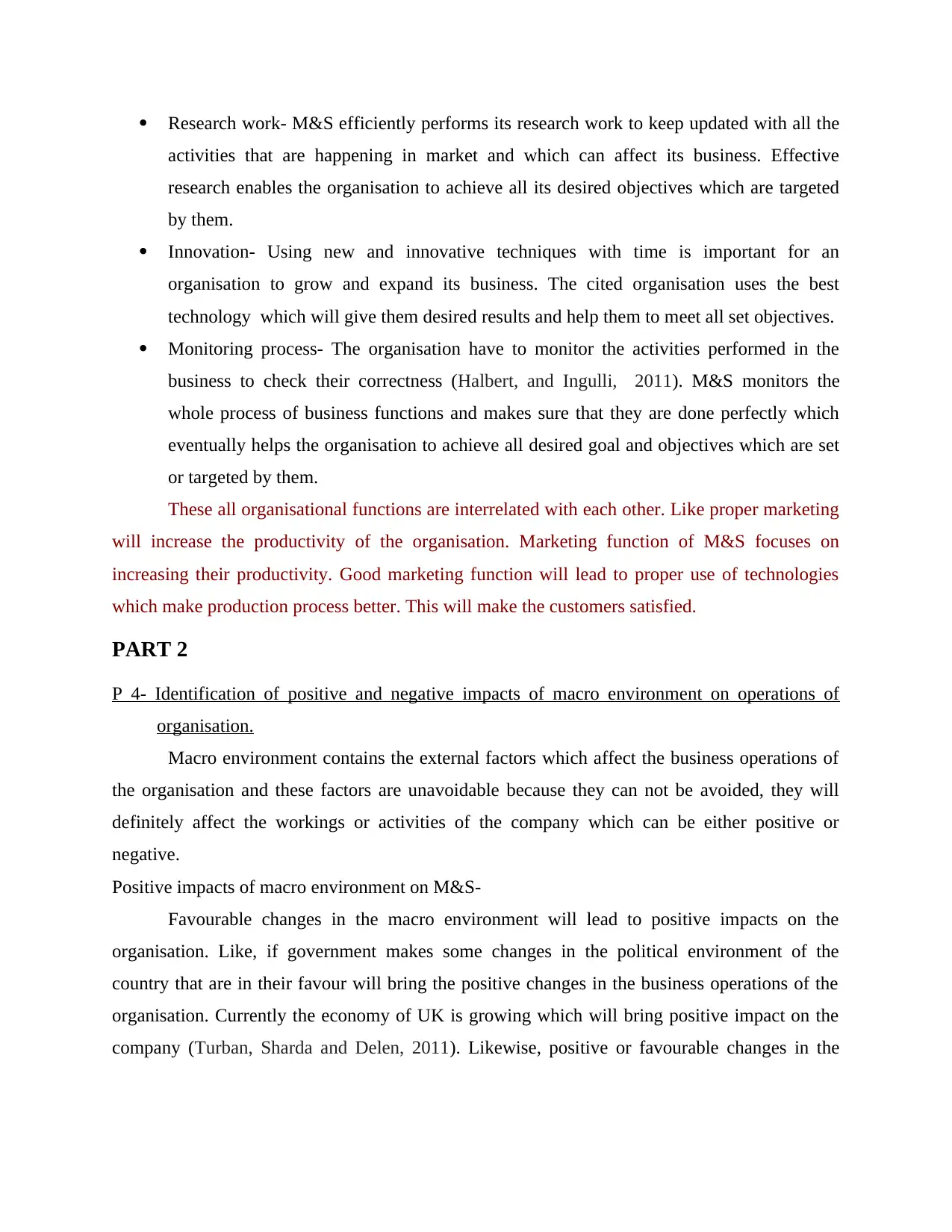
Research work- M&S efficiently performs its research work to keep updated with all the
activities that are happening in market and which can affect its business. Effective
research enables the organisation to achieve all its desired objectives which are targeted
by them.
Innovation- Using new and innovative techniques with time is important for an
organisation to grow and expand its business. The cited organisation uses the best
technology which will give them desired results and help them to meet all set objectives.
Monitoring process- The organisation have to monitor the activities performed in the
business to check their correctness (Halbert, and Ingulli, 2011). M&S monitors the
whole process of business functions and makes sure that they are done perfectly which
eventually helps the organisation to achieve all desired goal and objectives which are set
or targeted by them.
These all organisational functions are interrelated with each other. Like proper marketing
will increase the productivity of the organisation. Marketing function of M&S focuses on
increasing their productivity. Good marketing function will lead to proper use of technologies
which make production process better. This will make the customers satisfied.
PART 2
P 4- Identification of positive and negative impacts of macro environment on operations of
organisation.
Macro environment contains the external factors which affect the business operations of
the organisation and these factors are unavoidable because they can not be avoided, they will
definitely affect the workings or activities of the company which can be either positive or
negative.
Positive impacts of macro environment on M&S-
Favourable changes in the macro environment will lead to positive impacts on the
organisation. Like, if government makes some changes in the political environment of the
country that are in their favour will bring the positive changes in the business operations of the
organisation. Currently the economy of UK is growing which will bring positive impact on the
company (Turban, Sharda and Delen, 2011). Likewise, positive or favourable changes in the
activities that are happening in market and which can affect its business. Effective
research enables the organisation to achieve all its desired objectives which are targeted
by them.
Innovation- Using new and innovative techniques with time is important for an
organisation to grow and expand its business. The cited organisation uses the best
technology which will give them desired results and help them to meet all set objectives.
Monitoring process- The organisation have to monitor the activities performed in the
business to check their correctness (Halbert, and Ingulli, 2011). M&S monitors the
whole process of business functions and makes sure that they are done perfectly which
eventually helps the organisation to achieve all desired goal and objectives which are set
or targeted by them.
These all organisational functions are interrelated with each other. Like proper marketing
will increase the productivity of the organisation. Marketing function of M&S focuses on
increasing their productivity. Good marketing function will lead to proper use of technologies
which make production process better. This will make the customers satisfied.
PART 2
P 4- Identification of positive and negative impacts of macro environment on operations of
organisation.
Macro environment contains the external factors which affect the business operations of
the organisation and these factors are unavoidable because they can not be avoided, they will
definitely affect the workings or activities of the company which can be either positive or
negative.
Positive impacts of macro environment on M&S-
Favourable changes in the macro environment will lead to positive impacts on the
organisation. Like, if government makes some changes in the political environment of the
country that are in their favour will bring the positive changes in the business operations of the
organisation. Currently the economy of UK is growing which will bring positive impact on the
company (Turban, Sharda and Delen, 2011). Likewise, positive or favourable changes in the
Paraphrase This Document
Need a fresh take? Get an instant paraphrase of this document with our AI Paraphraser
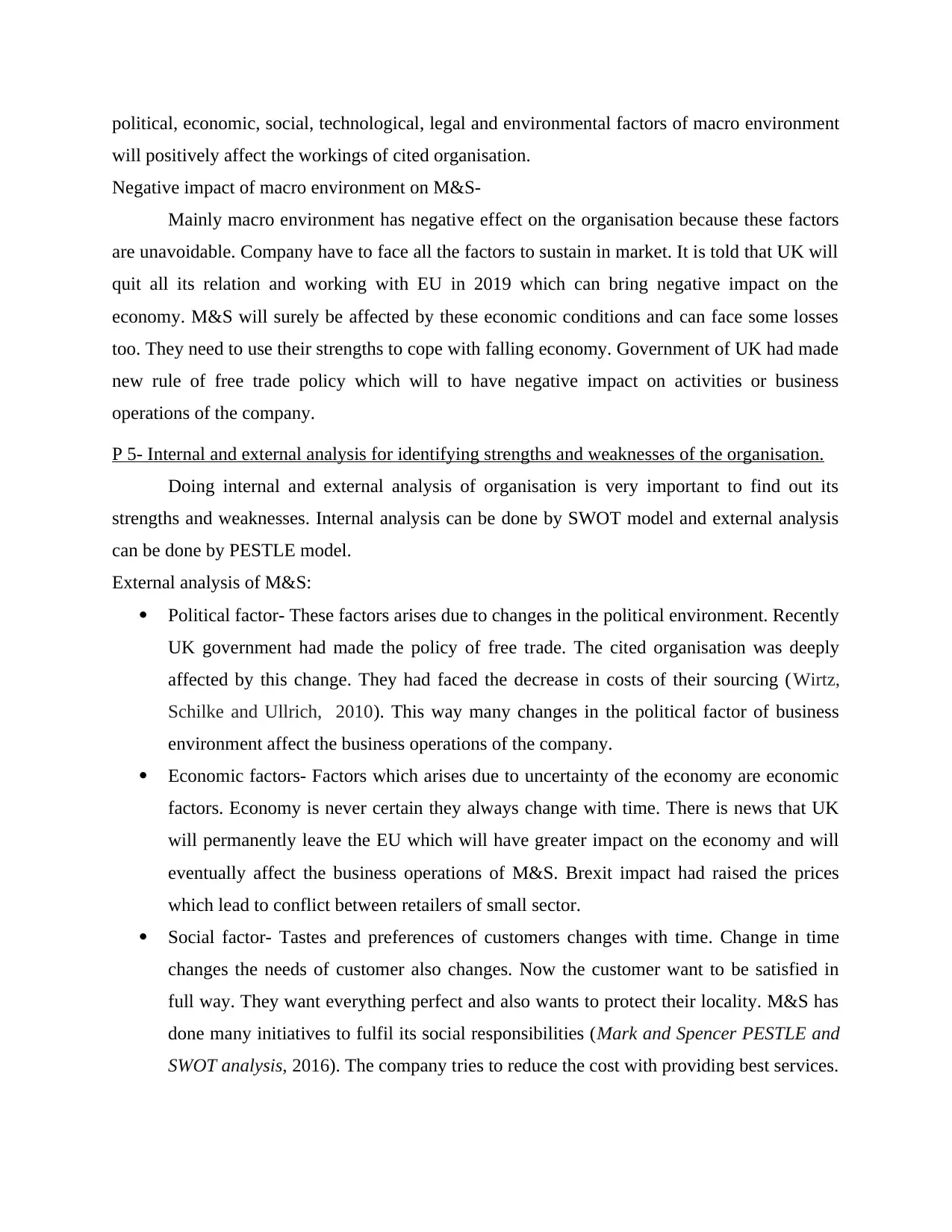
political, economic, social, technological, legal and environmental factors of macro environment
will positively affect the workings of cited organisation.
Negative impact of macro environment on M&S-
Mainly macro environment has negative effect on the organisation because these factors
are unavoidable. Company have to face all the factors to sustain in market. It is told that UK will
quit all its relation and working with EU in 2019 which can bring negative impact on the
economy. M&S will surely be affected by these economic conditions and can face some losses
too. They need to use their strengths to cope with falling economy. Government of UK had made
new rule of free trade policy which will to have negative impact on activities or business
operations of the company.
P 5- Internal and external analysis for identifying strengths and weaknesses of the organisation.
Doing internal and external analysis of organisation is very important to find out its
strengths and weaknesses. Internal analysis can be done by SWOT model and external analysis
can be done by PESTLE model.
External analysis of M&S:
Political factor- These factors arises due to changes in the political environment. Recently
UK government had made the policy of free trade. The cited organisation was deeply
affected by this change. They had faced the decrease in costs of their sourcing (Wirtz,
Schilke and Ullrich, 2010). This way many changes in the political factor of business
environment affect the business operations of the company.
Economic factors- Factors which arises due to uncertainty of the economy are economic
factors. Economy is never certain they always change with time. There is news that UK
will permanently leave the EU which will have greater impact on the economy and will
eventually affect the business operations of M&S. Brexit impact had raised the prices
which lead to conflict between retailers of small sector.
Social factor- Tastes and preferences of customers changes with time. Change in time
changes the needs of customer also changes. Now the customer want to be satisfied in
full way. They want everything perfect and also wants to protect their locality. M&S has
done many initiatives to fulfil its social responsibilities (Mark and Spencer PESTLE and
SWOT analysis, 2016). The company tries to reduce the cost with providing best services.
will positively affect the workings of cited organisation.
Negative impact of macro environment on M&S-
Mainly macro environment has negative effect on the organisation because these factors
are unavoidable. Company have to face all the factors to sustain in market. It is told that UK will
quit all its relation and working with EU in 2019 which can bring negative impact on the
economy. M&S will surely be affected by these economic conditions and can face some losses
too. They need to use their strengths to cope with falling economy. Government of UK had made
new rule of free trade policy which will to have negative impact on activities or business
operations of the company.
P 5- Internal and external analysis for identifying strengths and weaknesses of the organisation.
Doing internal and external analysis of organisation is very important to find out its
strengths and weaknesses. Internal analysis can be done by SWOT model and external analysis
can be done by PESTLE model.
External analysis of M&S:
Political factor- These factors arises due to changes in the political environment. Recently
UK government had made the policy of free trade. The cited organisation was deeply
affected by this change. They had faced the decrease in costs of their sourcing (Wirtz,
Schilke and Ullrich, 2010). This way many changes in the political factor of business
environment affect the business operations of the company.
Economic factors- Factors which arises due to uncertainty of the economy are economic
factors. Economy is never certain they always change with time. There is news that UK
will permanently leave the EU which will have greater impact on the economy and will
eventually affect the business operations of M&S. Brexit impact had raised the prices
which lead to conflict between retailers of small sector.
Social factor- Tastes and preferences of customers changes with time. Change in time
changes the needs of customer also changes. Now the customer want to be satisfied in
full way. They want everything perfect and also wants to protect their locality. M&S has
done many initiatives to fulfil its social responsibilities (Mark and Spencer PESTLE and
SWOT analysis, 2016). The company tries to reduce the cost with providing best services.
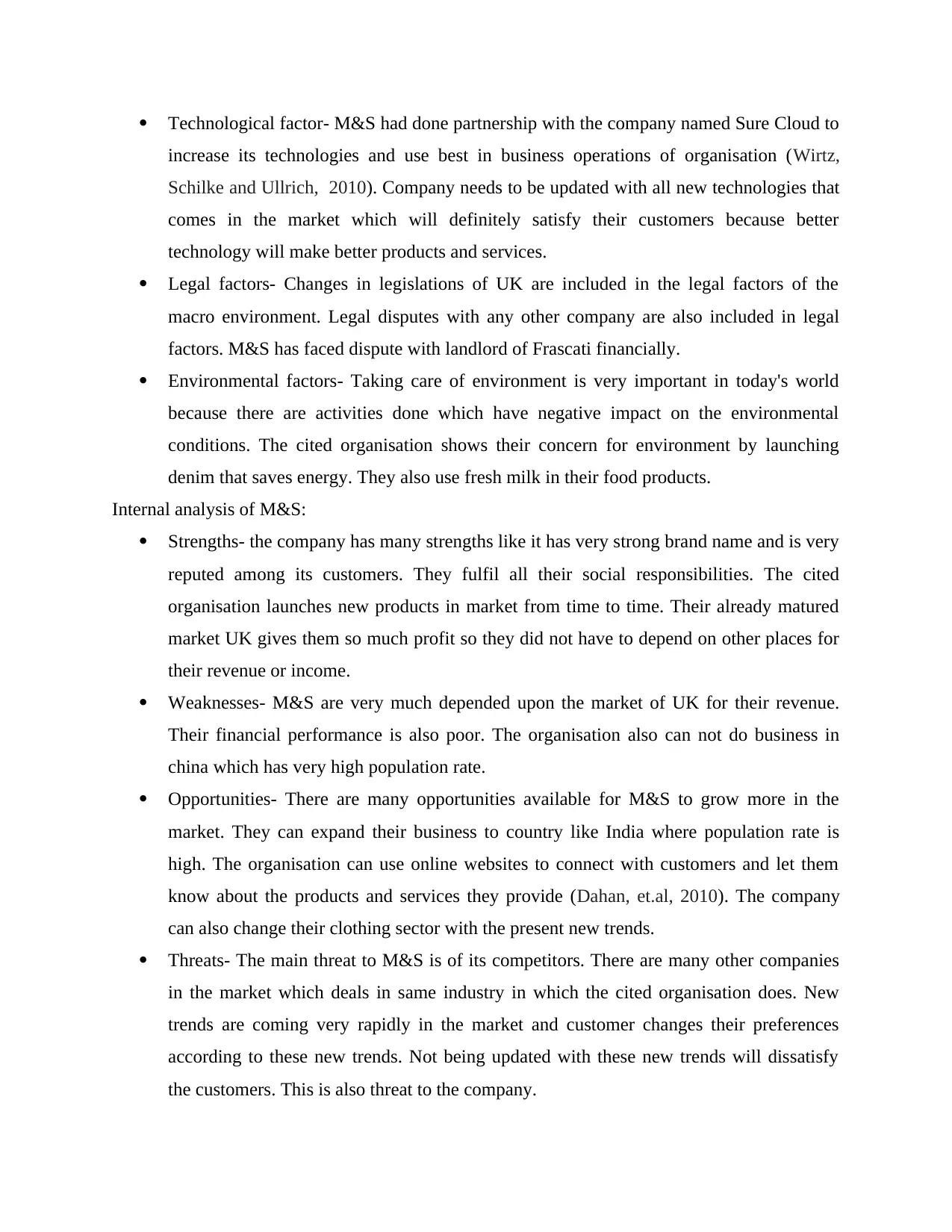
Technological factor- M&S had done partnership with the company named Sure Cloud to
increase its technologies and use best in business operations of organisation (Wirtz,
Schilke and Ullrich, 2010). Company needs to be updated with all new technologies that
comes in the market which will definitely satisfy their customers because better
technology will make better products and services.
Legal factors- Changes in legislations of UK are included in the legal factors of the
macro environment. Legal disputes with any other company are also included in legal
factors. M&S has faced dispute with landlord of Frascati financially.
Environmental factors- Taking care of environment is very important in today's world
because there are activities done which have negative impact on the environmental
conditions. The cited organisation shows their concern for environment by launching
denim that saves energy. They also use fresh milk in their food products.
Internal analysis of M&S:
Strengths- the company has many strengths like it has very strong brand name and is very
reputed among its customers. They fulfil all their social responsibilities. The cited
organisation launches new products in market from time to time. Their already matured
market UK gives them so much profit so they did not have to depend on other places for
their revenue or income.
Weaknesses- M&S are very much depended upon the market of UK for their revenue.
Their financial performance is also poor. The organisation also can not do business in
china which has very high population rate.
Opportunities- There are many opportunities available for M&S to grow more in the
market. They can expand their business to country like India where population rate is
high. The organisation can use online websites to connect with customers and let them
know about the products and services they provide (Dahan, et.al, 2010). The company
can also change their clothing sector with the present new trends.
Threats- The main threat to M&S is of its competitors. There are many other companies
in the market which deals in same industry in which the cited organisation does. New
trends are coming very rapidly in the market and customer changes their preferences
according to these new trends. Not being updated with these new trends will dissatisfy
the customers. This is also threat to the company.
increase its technologies and use best in business operations of organisation (Wirtz,
Schilke and Ullrich, 2010). Company needs to be updated with all new technologies that
comes in the market which will definitely satisfy their customers because better
technology will make better products and services.
Legal factors- Changes in legislations of UK are included in the legal factors of the
macro environment. Legal disputes with any other company are also included in legal
factors. M&S has faced dispute with landlord of Frascati financially.
Environmental factors- Taking care of environment is very important in today's world
because there are activities done which have negative impact on the environmental
conditions. The cited organisation shows their concern for environment by launching
denim that saves energy. They also use fresh milk in their food products.
Internal analysis of M&S:
Strengths- the company has many strengths like it has very strong brand name and is very
reputed among its customers. They fulfil all their social responsibilities. The cited
organisation launches new products in market from time to time. Their already matured
market UK gives them so much profit so they did not have to depend on other places for
their revenue or income.
Weaknesses- M&S are very much depended upon the market of UK for their revenue.
Their financial performance is also poor. The organisation also can not do business in
china which has very high population rate.
Opportunities- There are many opportunities available for M&S to grow more in the
market. They can expand their business to country like India where population rate is
high. The organisation can use online websites to connect with customers and let them
know about the products and services they provide (Dahan, et.al, 2010). The company
can also change their clothing sector with the present new trends.
Threats- The main threat to M&S is of its competitors. There are many other companies
in the market which deals in same industry in which the cited organisation does. New
trends are coming very rapidly in the market and customer changes their preferences
according to these new trends. Not being updated with these new trends will dissatisfy
the customers. This is also threat to the company.
⊘ This is a preview!⊘
Do you want full access?
Subscribe today to unlock all pages.

Trusted by 1+ million students worldwide
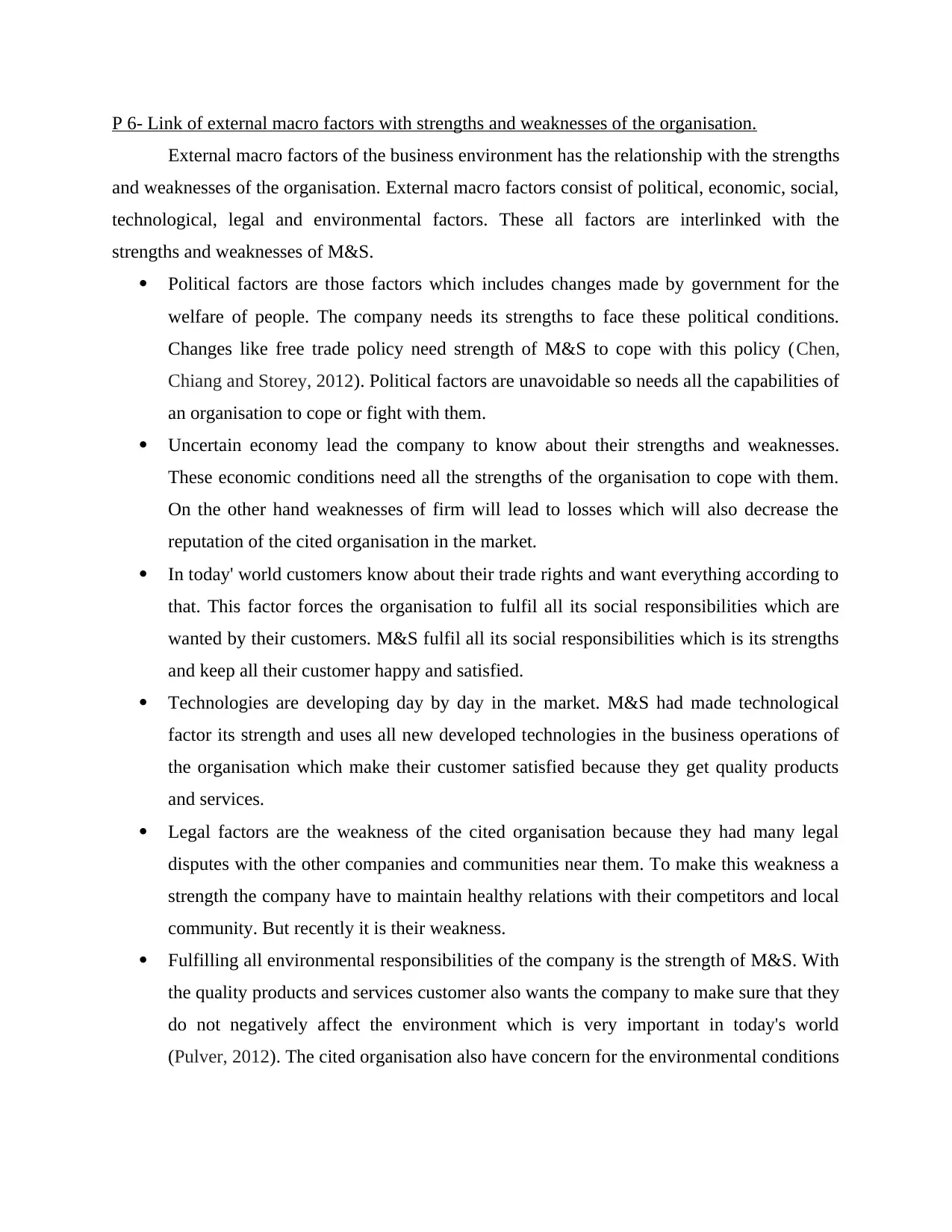
P 6- Link of external macro factors with strengths and weaknesses of the organisation.
External macro factors of the business environment has the relationship with the strengths
and weaknesses of the organisation. External macro factors consist of political, economic, social,
technological, legal and environmental factors. These all factors are interlinked with the
strengths and weaknesses of M&S.
Political factors are those factors which includes changes made by government for the
welfare of people. The company needs its strengths to face these political conditions.
Changes like free trade policy need strength of M&S to cope with this policy (Chen,
Chiang and Storey, 2012). Political factors are unavoidable so needs all the capabilities of
an organisation to cope or fight with them.
Uncertain economy lead the company to know about their strengths and weaknesses.
These economic conditions need all the strengths of the organisation to cope with them.
On the other hand weaknesses of firm will lead to losses which will also decrease the
reputation of the cited organisation in the market.
In today' world customers know about their trade rights and want everything according to
that. This factor forces the organisation to fulfil all its social responsibilities which are
wanted by their customers. M&S fulfil all its social responsibilities which is its strengths
and keep all their customer happy and satisfied.
Technologies are developing day by day in the market. M&S had made technological
factor its strength and uses all new developed technologies in the business operations of
the organisation which make their customer satisfied because they get quality products
and services.
Legal factors are the weakness of the cited organisation because they had many legal
disputes with the other companies and communities near them. To make this weakness a
strength the company have to maintain healthy relations with their competitors and local
community. But recently it is their weakness.
Fulfilling all environmental responsibilities of the company is the strength of M&S. With
the quality products and services customer also wants the company to make sure that they
do not negatively affect the environment which is very important in today's world
(Pulver, 2012). The cited organisation also have concern for the environmental conditions
External macro factors of the business environment has the relationship with the strengths
and weaknesses of the organisation. External macro factors consist of political, economic, social,
technological, legal and environmental factors. These all factors are interlinked with the
strengths and weaknesses of M&S.
Political factors are those factors which includes changes made by government for the
welfare of people. The company needs its strengths to face these political conditions.
Changes like free trade policy need strength of M&S to cope with this policy (Chen,
Chiang and Storey, 2012). Political factors are unavoidable so needs all the capabilities of
an organisation to cope or fight with them.
Uncertain economy lead the company to know about their strengths and weaknesses.
These economic conditions need all the strengths of the organisation to cope with them.
On the other hand weaknesses of firm will lead to losses which will also decrease the
reputation of the cited organisation in the market.
In today' world customers know about their trade rights and want everything according to
that. This factor forces the organisation to fulfil all its social responsibilities which are
wanted by their customers. M&S fulfil all its social responsibilities which is its strengths
and keep all their customer happy and satisfied.
Technologies are developing day by day in the market. M&S had made technological
factor its strength and uses all new developed technologies in the business operations of
the organisation which make their customer satisfied because they get quality products
and services.
Legal factors are the weakness of the cited organisation because they had many legal
disputes with the other companies and communities near them. To make this weakness a
strength the company have to maintain healthy relations with their competitors and local
community. But recently it is their weakness.
Fulfilling all environmental responsibilities of the company is the strength of M&S. With
the quality products and services customer also wants the company to make sure that they
do not negatively affect the environment which is very important in today's world
(Pulver, 2012). The cited organisation also have concern for the environmental conditions
Paraphrase This Document
Need a fresh take? Get an instant paraphrase of this document with our AI Paraphraser
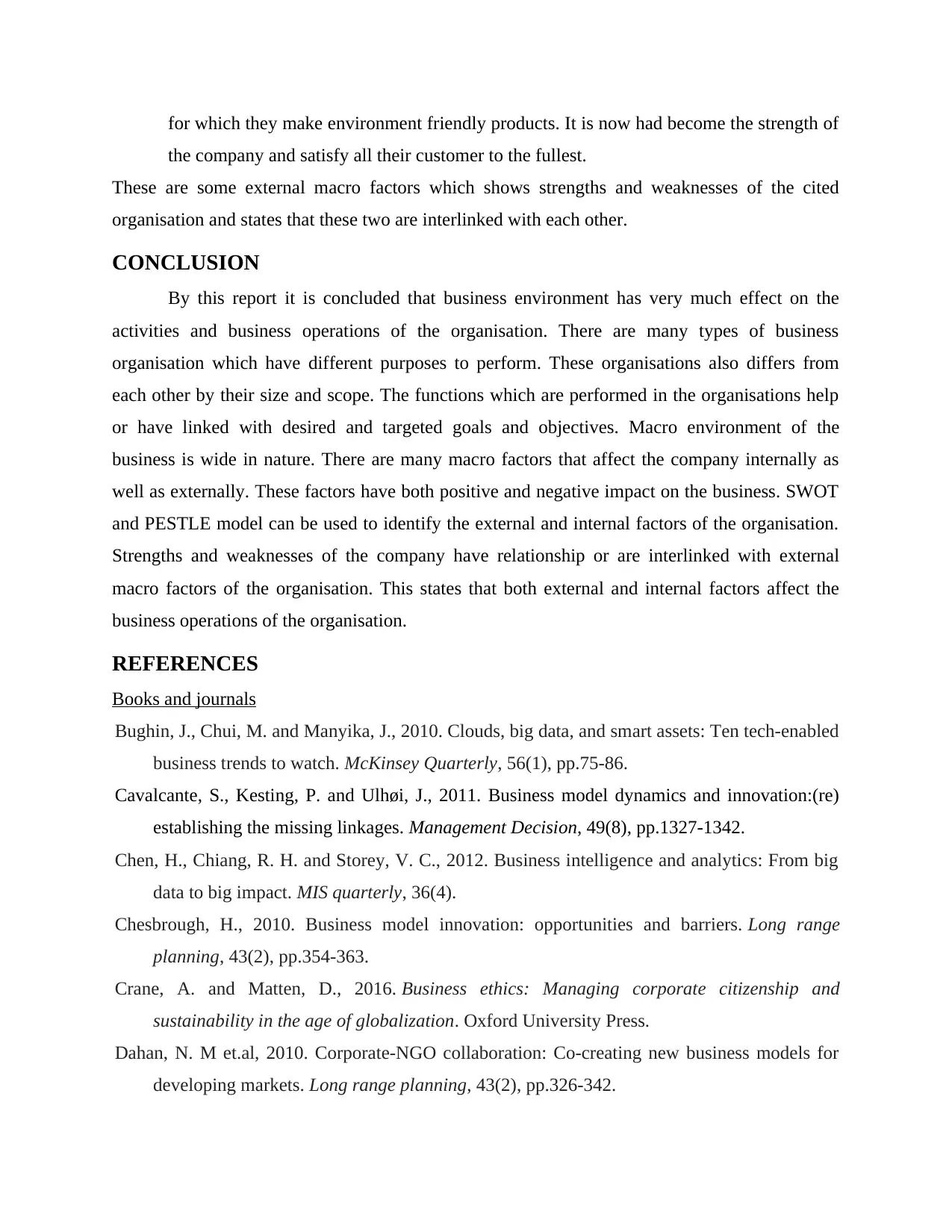
for which they make environment friendly products. It is now had become the strength of
the company and satisfy all their customer to the fullest.
These are some external macro factors which shows strengths and weaknesses of the cited
organisation and states that these two are interlinked with each other.
CONCLUSION
By this report it is concluded that business environment has very much effect on the
activities and business operations of the organisation. There are many types of business
organisation which have different purposes to perform. These organisations also differs from
each other by their size and scope. The functions which are performed in the organisations help
or have linked with desired and targeted goals and objectives. Macro environment of the
business is wide in nature. There are many macro factors that affect the company internally as
well as externally. These factors have both positive and negative impact on the business. SWOT
and PESTLE model can be used to identify the external and internal factors of the organisation.
Strengths and weaknesses of the company have relationship or are interlinked with external
macro factors of the organisation. This states that both external and internal factors affect the
business operations of the organisation.
REFERENCES
Books and journals
Bughin, J., Chui, M. and Manyika, J., 2010. Clouds, big data, and smart assets: Ten tech-enabled
business trends to watch. McKinsey Quarterly, 56(1), pp.75-86.
Cavalcante, S., Kesting, P. and Ulhøi, J., 2011. Business model dynamics and innovation:(re)
establishing the missing linkages. Management Decision, 49(8), pp.1327-1342.
Chen, H., Chiang, R. H. and Storey, V. C., 2012. Business intelligence and analytics: From big
data to big impact. MIS quarterly, 36(4).
Chesbrough, H., 2010. Business model innovation: opportunities and barriers. Long range
planning, 43(2), pp.354-363.
Crane, A. and Matten, D., 2016. Business ethics: Managing corporate citizenship and
sustainability in the age of globalization. Oxford University Press.
Dahan, N. M et.al, 2010. Corporate-NGO collaboration: Co-creating new business models for
developing markets. Long range planning, 43(2), pp.326-342.
the company and satisfy all their customer to the fullest.
These are some external macro factors which shows strengths and weaknesses of the cited
organisation and states that these two are interlinked with each other.
CONCLUSION
By this report it is concluded that business environment has very much effect on the
activities and business operations of the organisation. There are many types of business
organisation which have different purposes to perform. These organisations also differs from
each other by their size and scope. The functions which are performed in the organisations help
or have linked with desired and targeted goals and objectives. Macro environment of the
business is wide in nature. There are many macro factors that affect the company internally as
well as externally. These factors have both positive and negative impact on the business. SWOT
and PESTLE model can be used to identify the external and internal factors of the organisation.
Strengths and weaknesses of the company have relationship or are interlinked with external
macro factors of the organisation. This states that both external and internal factors affect the
business operations of the organisation.
REFERENCES
Books and journals
Bughin, J., Chui, M. and Manyika, J., 2010. Clouds, big data, and smart assets: Ten tech-enabled
business trends to watch. McKinsey Quarterly, 56(1), pp.75-86.
Cavalcante, S., Kesting, P. and Ulhøi, J., 2011. Business model dynamics and innovation:(re)
establishing the missing linkages. Management Decision, 49(8), pp.1327-1342.
Chen, H., Chiang, R. H. and Storey, V. C., 2012. Business intelligence and analytics: From big
data to big impact. MIS quarterly, 36(4).
Chesbrough, H., 2010. Business model innovation: opportunities and barriers. Long range
planning, 43(2), pp.354-363.
Crane, A. and Matten, D., 2016. Business ethics: Managing corporate citizenship and
sustainability in the age of globalization. Oxford University Press.
Dahan, N. M et.al, 2010. Corporate-NGO collaboration: Co-creating new business models for
developing markets. Long range planning, 43(2), pp.326-342.
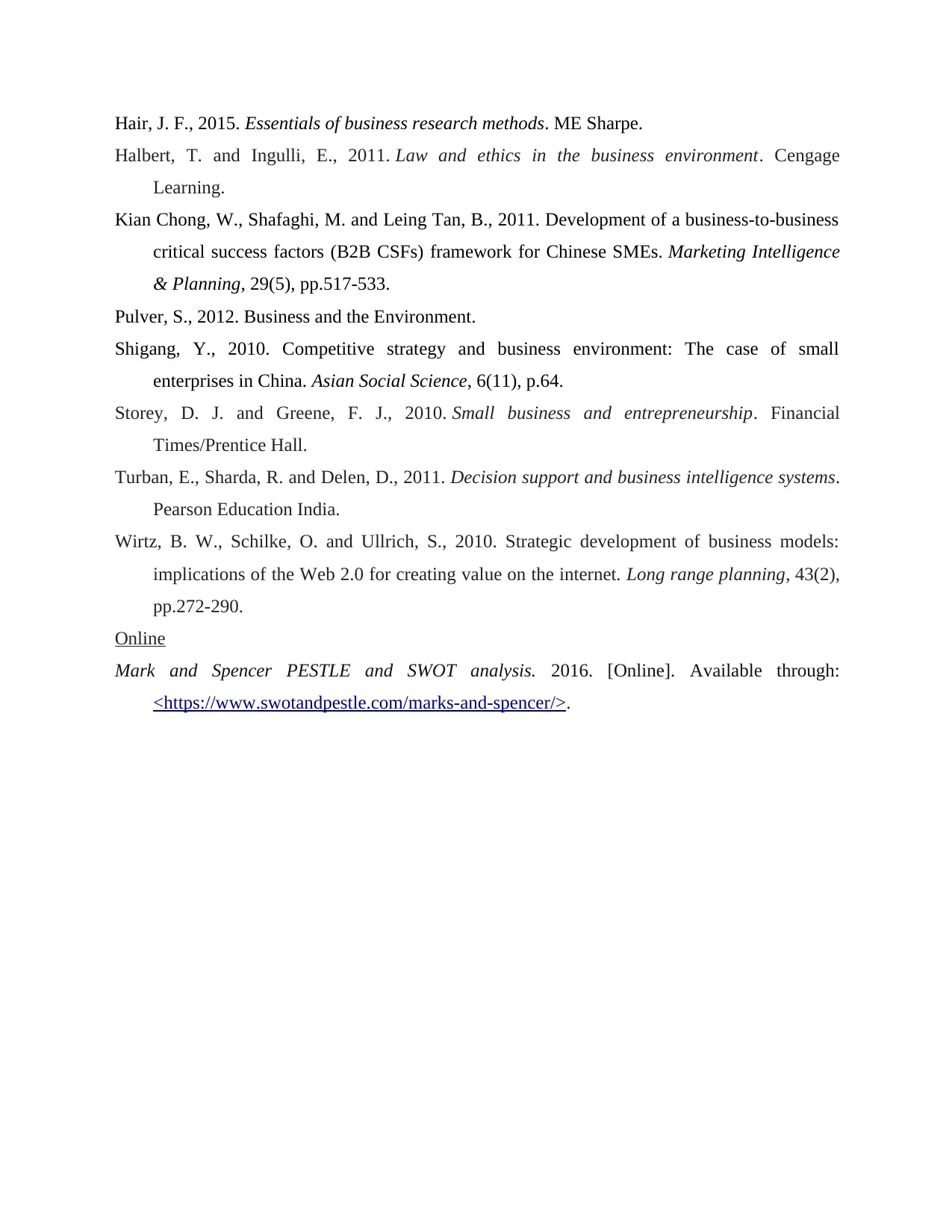
Hair, J. F., 2015. Essentials of business research methods. ME Sharpe.
Halbert, T. and Ingulli, E., 2011. Law and ethics in the business environment. Cengage
Learning.
Kian Chong, W., Shafaghi, M. and Leing Tan, B., 2011. Development of a business-to-business
critical success factors (B2B CSFs) framework for Chinese SMEs. Marketing Intelligence
& Planning, 29(5), pp.517-533.
Pulver, S., 2012. Business and the Environment.
Shigang, Y., 2010. Competitive strategy and business environment: The case of small
enterprises in China. Asian Social Science, 6(11), p.64.
Storey, D. J. and Greene, F. J., 2010. Small business and entrepreneurship. Financial
Times/Prentice Hall.
Turban, E., Sharda, R. and Delen, D., 2011. Decision support and business intelligence systems.
Pearson Education India.
Wirtz, B. W., Schilke, O. and Ullrich, S., 2010. Strategic development of business models:
implications of the Web 2.0 for creating value on the internet. Long range planning, 43(2),
pp.272-290.
Online
Mark and Spencer PESTLE and SWOT analysis. 2016. [Online]. Available through:
<https://www.swotandpestle.com/marks-and-spencer/>.
Halbert, T. and Ingulli, E., 2011. Law and ethics in the business environment. Cengage
Learning.
Kian Chong, W., Shafaghi, M. and Leing Tan, B., 2011. Development of a business-to-business
critical success factors (B2B CSFs) framework for Chinese SMEs. Marketing Intelligence
& Planning, 29(5), pp.517-533.
Pulver, S., 2012. Business and the Environment.
Shigang, Y., 2010. Competitive strategy and business environment: The case of small
enterprises in China. Asian Social Science, 6(11), p.64.
Storey, D. J. and Greene, F. J., 2010. Small business and entrepreneurship. Financial
Times/Prentice Hall.
Turban, E., Sharda, R. and Delen, D., 2011. Decision support and business intelligence systems.
Pearson Education India.
Wirtz, B. W., Schilke, O. and Ullrich, S., 2010. Strategic development of business models:
implications of the Web 2.0 for creating value on the internet. Long range planning, 43(2),
pp.272-290.
Online
Mark and Spencer PESTLE and SWOT analysis. 2016. [Online]. Available through:
<https://www.swotandpestle.com/marks-and-spencer/>.
⊘ This is a preview!⊘
Do you want full access?
Subscribe today to unlock all pages.

Trusted by 1+ million students worldwide
1 out of 13
Related Documents
Your All-in-One AI-Powered Toolkit for Academic Success.
+13062052269
info@desklib.com
Available 24*7 on WhatsApp / Email
![[object Object]](/_next/static/media/star-bottom.7253800d.svg)
Unlock your academic potential
Copyright © 2020–2025 A2Z Services. All Rights Reserved. Developed and managed by ZUCOL.





